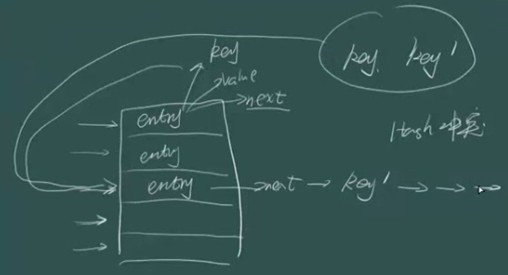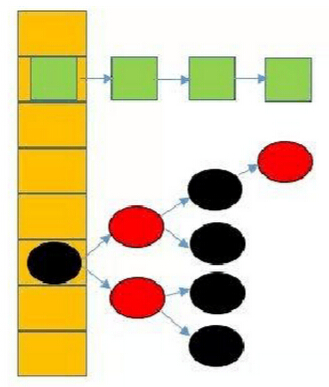JDK7与JDK8中HashMap的实现
JDK7中的HashMap
HashMap底层维护一个数组,数组中的每一项都是一个Entry
|
1
|
transient Entry<K,V>[] table; |
我们向 HashMap 中所放置的对象实际上是存储在该数组当中;
而Map中的key,value则以Entry的形式存放在数组中
|
1
2
3
4
5
|
static class Entry<K,V> implements Map.Entry<K,V> { final K key; V value; Entry<K,V> next; int hash; |
而这个Entry应该放在数组的哪一个位置上(这个位置通常称为位桶或者hash桶,即hash值相同的Entry会放在同一位置,用链表相连),是通过key的hashCode来计算的。
|
1
2
3
4
5
6
7
|
final int hash(Object k) { int h = 0; h ^= k.hashCode(); h ^= (h >>> 20) ^ (h >>> 12); return h ^ (h >>> 7) ^ (h >>> 4); } |
通过hash计算出来的值将会使用indexFor方法找到它应该所在的table下标:
|
1
2
3
|
static int indexFor(int h, int length) { return h & (length-1); } |
这个方法其实相当于对table.length取模。
当两个key通过hashCode计算相同时,则发生了hash冲突(碰撞),HashMap解决hash冲突的方式是用链表。
当发生hash冲突时,则将存放在数组中的Entry设置为新值的next(这里要注意的是,比如A和B都hash后都映射到下标i中,之前已经有A了,当map.put(B)时,将B放到下标i中,A则为B的next,所以新值存放在数组中,旧值在新值的链表上)
示意图:

所以当hash冲突很多时,HashMap退化成链表。
总结一下map.put后的过程:
当向 HashMap 中 put 一对键值时,它会根据 key的 hashCode 值计算出一个位置, 该位置就是此对象准备往数组中存放的位置。
如果该位置没有对象存在,就将此对象直接放进数组当中;如果该位置已经有对象存在了,则顺着此存在的对象的链开始寻找(为了判断是否是否值相同,map不允许<key,value>键值对重复), 如果此链上有对象的话,再去使用 equals方法进行比较,如果对此链上的每个对象的 equals 方法比较都为 false,则将该对象放到数组当中,然后将数组中该位置以前存在的那个对象链接到此对象的后面。
值得注意的是,当key为null时,都放到table[0]中
|
1
2
3
4
5
6
7
8
9
10
11
12
13
|
private V putForNullKey(V value) { for (Entry<K,V> e = table[0]; e != null; e = e.next) { if (e.key == null) { V oldValue = e.value; e.value = value; e.recordAccess(this); return oldValue; } } modCount++; addEntry(0, null, value, 0); return null; } |
当size大于threshold时,会发生扩容。 threshold等于capacity*load factor
|
1
2
3
4
5
6
7
8
9
|
void addEntry(int hash, K key, V value, int bucketIndex) { if ((size >= threshold) && (null != table[bucketIndex])) { resize(2 * table.length); hash = (null != key) ? hash(key) : 0; bucketIndex = indexFor(hash, table.length); } createEntry(hash, key, value, bucketIndex); } |
jdk7中resize,只有当 size>=threshold并且 table中的那个槽中已经有Entry时,才会发生resize。即有可能虽然size>=threshold,但是必须等到每个槽都至少有一个Entry时,才会扩容。还有注意每次resize都会扩大一倍容量
JDK8中的HashMap
一直到JDK7为止,HashMap的结构都是这么简单,基于一个数组以及多个链表的实现,hash值冲突的时候,就将对应节点以链表的形式存储。
这样子的HashMap性能上就抱有一定疑问,如果说成百上千个节点在hash时发生碰撞,存储一个链表中,那么如果要查找其中一个节点,那就不可避免的花费O(N)的查找时间,这将是多么大的性能损失。这个问题终于在JDK8中得到了解决。再最坏的情况下,链表查找的时间复杂度为O(n),而红黑树一直是O(logn),这样会提高HashMap的效率。
JDK7中HashMap采用的是位桶+链表的方式,即我们常说的散列链表的方式,而JDK8中采用的是位桶+链表/红黑树(有关红黑树请查看红黑树)的方式,也是非线程安全的。当某个位桶的链表的长度达到某个阀值的时候,这个链表就将转换成红黑树。

JDK8中,当同一个hash值的节点数不小于8时,将不再以单链表的形式存储了,会被调整成一颗红黑树(上图中null节点没画)。这就是JDK7与JDK8中HashMap实现的最大区别。
接下来,我们来看下JDK8中HashMap的源码实现。
JDK中Entry的名字变成了Node,原因是和红黑树的实现TreeNode相关联。
|
1
|
transient Node<K,V>[] table; |
当冲突节点数不小于8-1时,转换成红黑树。
|
1
|
static final int TREEIFY_THRESHOLD = 8; |
以put方法在JDK8中有了很大的改变
|
1
2
3
4
5
6
7
8
9
10
11
12
13
14
15
16
17
18
19
20
21
22
23
24
25
26
27
28
29
30
31
32
33
34
35
36
37
38
39
40
41
42
43
44
45
46
47
48
49
50
51
52
53
54
55
56
57
58
|
public V put(K key, V value) { return putVal(hash(key), key, value, false, true); }final V putVal(int hash, K key, V value, boolean onlyIfAbsent, boolean evict) { Node<K,V>[] tab; Node<K,V> p; int n, i; //如果当前map中无数据,执行resize方法。并且返回n if ((tab = table) == null || (n = tab.length) == 0) n = (tab = resize()).length; //如果要插入的键值对要存放的这个位置刚好没有元素,那么把他封装成Node对象,放在这个位置上就完事了 if ((p = tab[i = (n - 1) & hash]) == null) tab[i] = newNode(hash, key, value, null); //否则的话,说明这上面有元素 else { Node<K,V> e; K k; //如果这个元素的key与要插入的一样,那么就替换一下,也完事。 if (p.hash == hash && ((k = p.key) == key || (key != null && key.equals(k)))) e = p; //1.如果当前节点是TreeNode类型的数据,执行putTreeVal方法 else if (p instanceof TreeNode) e = ((TreeNode<K,V>)p).putTreeVal(this, tab, hash, key, value); else { //还是遍历这条链子上的数据,跟jdk7没什么区别 for (int binCount = 0; ; ++binCount) { if ((e = p.next) == null) { p.next = newNode(hash, key, value, null); //2.完成了操作后多做了一件事情,判断,并且可能执行treeifyBin方法 if (binCount >= TREEIFY_THRESHOLD - 1) // -1 for 1st treeifyBin(tab, hash); break; } if (e.hash == hash && ((k = e.key) == key || (key != null && key.equals(k)))) break; p = e; } } if (e != null) { // existing mapping for key V oldValue = e.value; if (!onlyIfAbsent || oldValue == null) //true || -- e.value = value; //3. afterNodeAccess(e); return oldValue; } } ++modCount; //判断阈值,决定是否扩容 if (++size > threshold) resize(); //4. afterNodeInsertion(evict); return null; } |
treeifyBin()就是将链表转换成红黑树。
之前的indefFor()方法消失 了,直接用(tab.length-1)&hash,所以看到这个,代表的就是数组的下角标。
|
1
2
3
4
|
static final int hash(Object key) { int h; return (key == null) ? 0 : (h = key.hashCode()) ^ (h >>> 16); } |





